A high percentage of American Indian men served in the military during World War II. During the war, nearly 25,000 American Indians served in the military and received the following awards: Air Medal (71), Silver Star (51), Bronze Star (47), Distinguished Flying Cross (34), and Congressional Medal of Honor (2). More than 480 Indians were killed during the war. While the armed services were segregated by race, Indians were generally integrated into Caucasian units.
A number of Indians achieved high military rank during the war. Brigadier General Clarence Tinker, an Osage from Oklahoma, headed the Hawaiian Air Force. Joseph (“Jocko”) Clark, a Cherokee from Oklahoma, was the only Indian naval admiral.
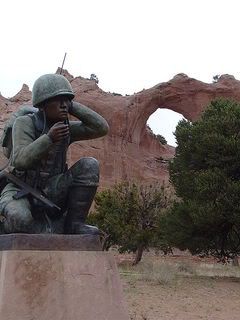
Culture Shock:
Indians often faced culture shock at boot camp. Navajo elders, for example, never raise their voice to obtain obedience and Navajo culture teaches that it is disrespectful to look someone in the eye. At boot camp the Navajo recruits were exposed to drill instructors who shouted at them and forced them to maintain eye contact.
Indians who had been to boarding schools already understood the basics of marching. Navajo code talker John Benally explains:
“We had been exposed to discipline, in some respects, during the old boarding school days within the Bureau of Indian Affairs. We were marched to school, the dining hall and church in formation. We knew how to drill, not in true military fashion, but we knew how to drill.”
The Code Talkers:
Native American “code talkers” who spoke their native languages were used to help facilitate rapid communication without enemy comprehension. The most famous of these are the Navajo Code Talkers. Initially, only 30 Navajo are recruited by the Marines to serve as “specialists” in an experimental unit. The unit developed a new military code which included 413 military phrases which was broadcast in their own language. For example, the Navajo word for “chicken hawk” is used to designate a dive bomber. The code baffled the Japanese. As the war continued, 421 Navajo were trained as code talkers.
It is ironic that many of the men who became Navajo code talkers had been punished, sometimes brutally, for speaking Navajo in government-run classrooms. The government which had punished them for their language prior to the war was now asking them to use their language to help them win the war.
The U.S. Army in both the Pacific and in Europe used Sioux Code Talkers who used Dakota, Lakota, and Nakota Sioux languages as code. As with the Navajo, the Sioux Code Talkers program was classified and the contribution of these soldiers was not officially recognized until long after the war.
Other military units used other tribal members as “code talkers.” This included Oneida, Chippewa, Choctaw, Sac and Fox, and Comanche. The Comanche were recruited by the Army for use in Europe because their language had no written form and could not be easily decoded by the Germans. The Choctaw code-talkers used the phrase posah-tai-vo, which means “crazy white man” as the code term for Adolph Hitler.
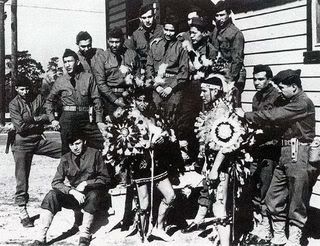
Action:
In 1942, U.S. Marine Navajo code talkers helped in the conquest of the island of Guadalcanal and patrols found that the code talkers made the difference between life and death.
In 1944, as the German army retreated, Oneida Indians from Wisconsin were the first Americans to enter Germany.
In 1945 the U.S. Marines captured the Japanese-held island of Iwo Jima and raised the American flag on Mount Suribachi. One of the marines who raised the flag was Ira Hayes, a Pima from Arizona. As an Indian marine shown in a famous photograph, Ira Hayes received a great deal of attention. For many he symbolized the hoped-for assimilation of Indians into the mainstream of American life.
Following the war, American Indian federal policies focused on assimilation, even though many of the returning vets found that they were denied the right to vote.
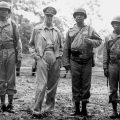
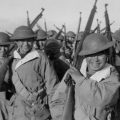
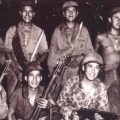
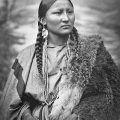
Leave a Reply